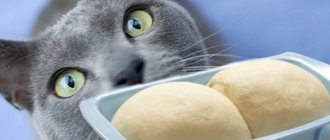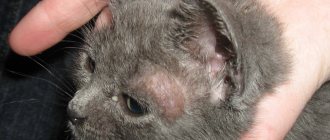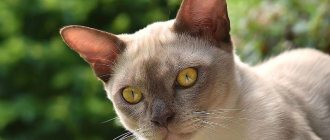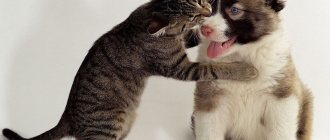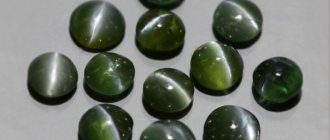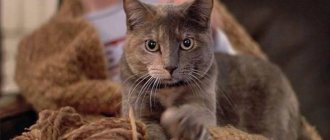Trimming your beloved pet's nails is a dual procedure. Someone constantly delays it, just to avoid outbursts of cat discontent and loud squeals. For some, giving their pet a pedicure seems like a real holiday. Much depends on the sleight of hand of the owner, on the temperament of the animal, and on a simple coincidence of circumstances. In order not to rely on the power of chance, let's talk about how to trim a cat's claws, avoiding heartbreaking dramas and assault.
How to trim a cat's claws
Structure of a cat's claw
A cat's claws are a keratinized layer of the epidermis that has a translucent whitish tint. They have a crescent shape, thanks to which the cat easily clings to many surfaces. The protein keratin, which makes up cat's claws, ensures their reliability and performs a protective function.
The idea of a cat's claw as an insensitive layer of dead cells is erroneous.
Despite the fact that this stratum corneum consists of half of dead cells, the cat's claw in no case loses its sensitivity. Only the very tip of the claw remains insensitive to various mechanical damage. The remaining surface has pulp underneath, containing both blood vessels and nerve endings. Therefore, deep damage to a cat’s claws is very painful.
Cats only take out their claws when necessary.
Thanks to special muscles and tendons, cats have the ability to retract their claws when they are not needed. This ability greatly facilitates the cat’s existence in everyday life and prevents various injuries.
What to do if blood comes from the claw
Rarely does a haircut succeed without incident - either the cat twitched, or the hair was too long. The main thing is to be prepared for anything. What do veterinarians say?
At home, only hemostatic powder or dry potassium permanganate are available. She can only stop the bleeding on her nails, but not on her skin - it risks a chemical burn.
In all cases, not excluding the above-mentioned bleeding, veterinarians are of the opinion that the care was professionally provided.
It is better not to carry out such procedures on your cat yourself - or first get advice and advice from a veterinarian.
Fingers
For many people, the phrase “cat toes” sounds unusual, but it is completely anatomically justified. Probably the reason for the misconception that cats have claws growing straight from their paws comes from the fact that the cat's toes are hidden under a layer of fur.
The fifth toe on the forelimbs most often remains invisible to the owner
On each cat's paw there are several toes, from which claws already grow. Unlike people, cats have a total of 18 fingers and the same number of claws:
- Cats have five toes on each of their front paws;
- The hind legs are equipped with only four toes.
The different number of fingers is associated with different functions that the hind and forelimbs are endowed with. The hind legs are used primarily as a support, while the front legs are an important defensive and hunting tool. Due to the divergent tasks, the structure of the claw on the front and hind paws is also different. The front claws are sharper, but at the same time brittle. They are more susceptible to delamination. The claws on the hind limbs are replaced less frequently and are more hard.
Polydactyly is common among both humans and animals.
The phenomenon of polydactyly or polydactyly also applies to felines. Exceeding the normal number of toes usually does not prevent cats from living and hunting. The Guinness Book of Records contains information about a record-breaking cat from Ontario with a total of 27 toes.
Recommended dosage
Tea is brewed at the rate of 1000 mg of dried bark per 1 glass of water. Leave for about 15 minutes and take 1 cup three times a day.
Dry extract in capsules: 100 mg every day (for osteoarthritis); 200 – 350 mg per day for immune support. Tincture: 1/4 - 1/2 teaspoon 2 - 3 times a day or according to instructions.
Cat's claw supplements come in different forms. As a rule, these are liquid extracts, teas, and capsules that are made from the bark of the plant.
The most commonly used dosage form these days is capsules. But the choice of the form of the drug directly depends on the purpose of administration.
If you have arthritis, then definitely buy the capsules as they need to be taken regularly. At the same time, just one cup of tea effectively helps those who suffer from irregular body pain.
Claw diseases in cats
As we have already learned, a strong-looking claw is only a superficial layer that protects a delicate layer of skin filled with nerve endings. Therefore, claw injuries and subsequent diseases associated with damage are not so uncommon. The list of existing claw diseases in cats is quite short and is often associated not with the epidermis itself, but with what surrounds it. This list includes:
- Paronochia is inflammation of the soft tissues located around the claw;
- Pionochia is a purulent inflammation in the claw area resulting from infection;
- Abnormal growth of claws is typical for older cats with weakening muscles that do not allow them to retract the claw in time and for cats with excess thyroid hormones.
Both paranochia and pyonochia occur due to the weakened immunity of the animal
Diseases leading to deterioration of claws
In addition to injuries and infections that get into the tissues surrounding the claw, there are a number of diseases that affect the pet’s body as a whole, leading, among other things, to changes in the claws. We will talk briefly about such diseases below.
Table 1. Diseases affecting claws in cats
| Name | Description |
Pemphigus | The disease is associated with a general weakening of the immune system and affects the animal’s skin in all its manifestations. Mostly young individuals are susceptible to the disease. Characteristic symptoms of pemphigus include superficial pustules that cover the animal’s skin, which later becomes covered with scales and crusts. Symptoms make themselves felt through redness of the animal’s nose and fingertips. Untreated pemphigus causes complications such as pyoderma |
Systemic circulatory lupus | This autoimmune disease is very rare in cats, due to a number of drugs, radiation or viral infections. The main symptoms of lupus include ulcers covering the entire body (including mucous membranes), peeling of the skin and the subsequent appearance of crusts, skin lesions in the area of the nail bed |
Onychomycosis | Fungal infections surround felines every day. Their penetration into the body is explained by a weakening of the immune system and needs to be strengthened, in addition to combating symptoms. Manifestations of the fungus include conspicuous crusts on the animal's paw pads that are yellow, black, or greenish in color. A cat infected with onychomycosis will often lick or bite its claws. Some individuals even experience lameness |
Alternatives to Nail Trimming
Many owners, tired of dealing with cat hooliganism, resort to a last resort - amputation of claws (onychectomy). During this procedure, the animal's claws are removed along with the finger bones. This is a very traumatic operation. Physical recovery alone will take six months. But the cat will never recover morally.
Without claws, the animal feels vulnerable. Coordination of movements is impaired. Many pets adapt, but many do not and die.
Claw amputation is prohibited in many EU countries and is considered cruelty.
There is another operation - tendectomy. During it, pieces of tendons are cut out. After this, the cat cannot release its claws. The operation is also crippling, leading to injury due to the inability to maintain balance.
How to trim a cat's claws
In addition to the standard nail clippers, which are the first to be found in every pet store, there are several other tools for cat “pedicure”. List of products used for trimming nails
Table 2. Tools for cat pedicure
Scissors | A classic and budget option, which cat owners most often limit themselves to. Manipulation with scissors does not cause any particular difficulties; their main disadvantage is the thickness of the blade, which increases the likelihood of capturing the sensitive part of the claw, equipped with blood vessels. |
Wire cutters | This option differs from scissors by a special notch in the blades that adapts to the shape of a cat’s claw. With the help of nippers, it is much more difficult to make a mistake and injure a cat’s claw, due to their ergonomics and specialization for cats. |
Guillotine trimmer | This specific tool is recommended for those cat owners who have already mastered the previous options and feel confident. The sharp blade of the trimmer extends when you press the handle and easily trims the tip of your pet's nail |
Nail file | This remedy is well known to every person, but it is used least often on animals. However, it is the file that allows you to complete the work started with a nail clipper. In a cat pedicure, just like in a human pedicure, uneven corners may remain, which are smoothed out thanks to filing |
Why do you need to trim your nails?
Claws are horny skin formations that grow throughout life. Under natural conditions, claws are regularly worn down during life. An animal does not need to worry about shortening its nails, as a person does: nature itself does manicures for cats. Those animals that their owners release to frolic in the wild wear off their claws by climbing trees and running on asphalt.
Domestic cats also try to trim their claws on the owner's walls, scratch the door frame and any wooden covering. How many times can you hear the indignation of owners about torn walls, upholstered furniture and numerous traces of cat scratches!
A scratching post allows cats to act in accordance with their instincts, but this does not help much - it’s trite, the cat can ignore the convenient device and enthusiastically continue to tear apart the corner of his favorite sofa. However, the scratching post will not have a significant effect on shortening the cat’s claws.
If you do not help the animal and do not trim the cat's claws, then long claws may grow into the pads of the paws, and the animal will suffer while walking.
How to trim an adult cat's claws?
The ritual of trimming the claws of kittens and adults is hardly different from each other. The only danger lies in the greater physical strength and sharpness of the teeth of an adult animal, which, if dissatisfied, can use them against you. Let's briefly go through the main stages of nail trimming:
- Before the procedure, make sure your hands and nail clipper are clean by lubricating them with alcohol. The use of rusty tools is strictly unacceptable;
Working with contaminated tools can, in the worst case, lead to blood poisoning in the animal.
- Choose a well-lit room. Natural light is desirable, but if there is none, then a lamp will do;
- Take the cat in your arms and sit with him for a while, establishing contact and calming the pet. If he is wary even before the procedure begins, the process itself will be more difficult;
- Press two fingers on your pet's paw pads and inspect the claw that comes out. You should see the whitish tip of the claw slowly fade to a pale pink base. This is precisely what should not be affected;
A pink tint indicates that sensitive skin is hidden under the claw.
- Determine in advance 2 mm from the beginning of the pulp and try it on using a tool. In this case, the instrument should be in the right hand of right-handers, in the left hand of left-handers;
- When holding a paw, do not press on it under any circumstances or change the force of pressure, since such changes will immediately cause anxiety in the pet and cause an instinctive desire to take the paw;
- Trim the claw by holding the tool perpendicular to it;
- If, after completing the procedure, you find uneven protrusions, treat them with a file;
- If your pet gets wounded, take a cotton pad and soak it in hydrogen peroxide. Place cotton wool on the cat's claw and hold it in your hands for a while.
Ignoring the fifth claw by the owner can lead to it growing into the animal’s skin
Important! Do not forget about the existence of a fifth claw, which, due to its location and size, usually remains hidden from the eyes of the owner. This claw wears down very slowly, but grows very quickly, which can one day cause it to dig into the cat's paw, causing pain and severe limping.
Video - Trimming a cat's claws
How to prepare for the procedure
The owner must know how to prepare for pruning. Most pets initially resist pruning with all their might. It is important to properly prepare your animal. It is better to choose a time when he is relaxed and in a good mood. You need to start with a paw massage so that the pet does not feel discomfort. Attention switches to other activities and objects.
In the first months, the kitten experiences fear, fear and even irritation. It can break free and run away, and if held by force, it can even bite or scratch a person.
You should not use physical force, as it is necessary to convince your furry pet that this procedure is absolutely safe for him, that he has nothing to be afraid of. Trimming should be done regularly; the animal will gradually get used to it.
Over time, a habit will appear, and to make this happen faster, you can use encouragement in the form of something tasty. In order for pruning to be taken calmly, you should not expose your pet to stress. The owner should talk to him affectionately and stroke him. If the cat is too scared, it is better to postpone the procedure.
scratching post
Monthly nail trimming does not always relieve your cat of the need to take care of her claws on her own. If you see that your pet, despite timely care, periodically looks for materials on which it wants to “practice,” then it makes sense to think about buying a scratching post. A scratching post will allow the cat’s other needs, which we talked about earlier, to be realized. Marking territory, kneading muscles, grinding claws - all this will be provided by a scratching post for your pet.
A flat scratching post is a convenient place to start introducing your cat to such devices.
Please note that not all cats accept scratching posts. There are times when owners, having bought a huge gaming complex for their cat, sell it as completely unnecessary. To decide whether your pet is interested in this type of leisure activity, you can start by getting acquainted with such a simple and cheap option as a flat scratching post. It is upholstered with a special hard material that allows the cat to successfully tear at it. Attached to some vertical surface, it will give your dog an initial idea of scratching posts and allow you to predict his reaction to such devices.
For some cats, the purpose of the scratching post remains a mystery.
A flat scratching post needs to be hung high enough so that the cat can stretch all its muscles while sharpening its claws. The minimum mounting height for such a scratching post is eighty centimeters.
Types of scratching posts
In addition to the flat version, there are the following types of scratching posts:
- Post – A cylindrical post covered with a stiff material (such as jute). At the top of such a pillar there is usually a platform on which the pet can climb if desired. Sometimes the posts are equipped with additional toys to attract attention, sometimes they make do with a minimalist design. You can make a claw post with your own hands by taking a leg from a table or coffee table and upholstering it with the appropriate type of fabric;
The stand is suitable for both adults and little ones
- A scratching post built into the play complex. On the Internet you can find many design solutions for the location of entire cat “palaces” in apartments. They combine posts, flat scratching posts, beds, and everything you can imagine. It would seem that the cat’s leisure time in such conditions is guaranteed, but sometimes it happens that the pet remains completely indifferent to such “architectural ensembles” in his honor;
Play complexes are upholstered with the same materials as flat scratching posts
All claws in one session, or one paw every day?
Everyone chooses a nail trimming scheme according to their own employment and the level of patience of the animal. How to trim a cat's claws in one fell swoop if she gets nervous and struggles? A short-term procedure in this case is impossible a priori, since everything may end with more or less neatly trimmed claws, but an unpleasant side effect can manifest itself in the form of irritation of the owner and severe fright of the animal.
After treating the claws, you need to praise the cat for its endurance
More humane, although it takes much longer, would be to repeat the procedure every day - it takes much less of the owner’s nerves per paw, and the cat will get used to the procedure in 4 days and will behave much calmer.
After treating the claws, you need to spend some time with your pet, praise him for his endurance (animals understand this very well), play with him, and treat him with a treat. This way, the animal will not develop a final and irrevocable aversion to trimming its claws - it will be interested in the process being completed as quickly and efficiently as possible, because it is followed by a reward.
If you notice blood on a claw, you should not panic
Why do my cat's claws peel?
The separation of the keratinized layer of the epidermis is characteristic equally of both humans and cats. However, due to the fact that cats use their claws much more actively, their deterioration affects the cat’s well-being and mood.
With peeling claws, the cat may show resistance when the owner tries to take the paw and look at the claw, and may show increased aggression due to the pain experienced. In addition, peeling claws are fraught with damage and even tearing out, so treating this problem with indifference is a big mistake.
Splitting claws cause significant discomfort to their owners.
Among the reasons why claws become separated are the following:
- Incorrect/lack of trimming. Even with frequent care of your pet's claws, there is a risk of their delamination. As already mentioned, any carelessly trimmed claw tends to cling and “tear.” A file can help in this situation, as it will bring the cat’s claw to the most streamlined shape. The lack of a haircut as such leads the cat to long, breaking off claws, which sooner or later will certainly begin to break and split;
In the absence of proper care, even the healthiest and strongest claws begin to peel.
- Lack of vitamins. Calcium and vitamins of group D are responsible for the strength of the keratinized layer of the epidermis, in a desperate search for which cats begin to chew their claws. In such cases, it would be a good idea to take your pet to the veterinarian and ask him about possible vitamin supplements, or foods rich in substances in which the pet is lacking. Biotin is often prescribed to cats with dehiscent claws, which should be taken twice a year. It replenishes the lack of calcium and allows you to restore the epidermis;
Vitamins allow the cat to keep his body in good shape
- Rapid growth of claws. Due to malfunctions of the thyroid gland, cats sometimes experience excessively rapid growth of their claws, which literally does not allow the owner to keep up with them with a nail clipper. Treatment for this disease lies in the veterinarian’s office, which will identify the causes of gland dysfunction and prescribe appropriate treatment with an accompanying vitamin complex for the general strengthening of the body and claws in particular.
Claw separation is often observed in nursing cats.
Claw separation is often found in pregnant and lactating cats due to the fact that she wastes all her physiological resources on feeding her offspring. In such cases, the above-mentioned calcium deficiency can be easily compensated with the help of vitamin supplements and specialized feed. As a rule, even without vitamin interventions, when kittens grow up, the cat’s claws return to their previous healthy state.
What not to do
It is also important to consider that some manipulations can be harmful to the health of the pet.
Do not do it:
- Place the cutting tool parallel to the nail plate, as this can lead to delamination.
- Skip the next manicure session.
- Trim an animal's claws if it is nervous, breaks out, or is aggressive. In such a situation, you can accidentally hurt or injure your pet.
- When pruning, do not touch the pulp, because bleeding and subsequent improper treatment can cause an inflammatory process.
- Carry out the procedure with blunt instruments. This is fraught with problems in the form of delamination or breaking of the claw.
- Plan several different activities related to pet hygiene for one day. This can negatively affect the cat's psychological health.
Required Tools
Pet stores offer a wide range of special tools to properly trim your cat's nails.
Nail clippers . These include special pruning shears, reinforced wire cutters, or nail clippers. These are all mechanical tools with a round claw cutout. But they all have one big drawback - the owner who is cutting the claw has difficulty seeing the length of the claw and the place from which it needs to be cut off.
Guillotine trimmer . This is a modern device, easy to use. With its help, the cut is made as rounded as possible. But there is also a drawback here - a working trimmer makes noise, which can frighten an already fearful pet.
Grinder . This is a sharpening stone with an abrasive coating that can be used to painlessly sharpen a claw and polish it.
Regular manicure scissors . But they must be used with caution and only for trimming soft tissues in kittens. This tool is not at all safe for adult cats.
It is important that all these tools are well sharpened and their handles are covered with non-slip material. Before use, the instrument must be treated with a disinfectant.
You will also need an antiseptic to stop the bleeding if a wound forms.
Top 5 Misconceptions About Cats You Believed
